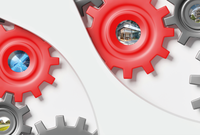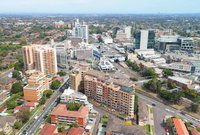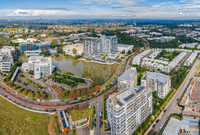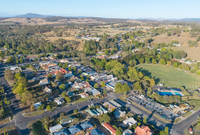Affordable & Liveable Property Guide 1st Half 2020 - Brisbane
The Brisbane Metro property market has shown resilience throughout these unprecedented times of COVID-19. From 2018 to 2019/20(1) the number of houses sold in Brisbane Metro increased by 20.9%, and median house prices grew by 1.5%, to $690,000. The number of units sold increased by 13.9%, however the median unit price softened by -1.5% to $450,000. These patterns are similar to Sydney and Melbourne, which also recorded a decline in median unit prices.

Overview
The Brisbane Metro property market has shown resilience throughout these unprecedented times of COVID-19. From 2018 to 2019/20(1) the number of houses sold in Brisbane Metro increased by 20.9%, and median house prices grew by 1.5%, to $690,000. The number of units sold increased by 13.9%, however the median unit price softened by -1.5% to $450,000. These patterns are similar to Sydney and Melbourne, which also recorded a decline in median unit prices.
Brisbane Metro offers unique opportunities. House owners can be more confident of their property value, as real capital growth has transpired, whereas unit buyers can capitalise on a more affordable market. For the first time in the Affordable & Liveable Property Guide series, the percentage premium added to the Queensland (QLD) average home loan to identify highly liveable suburbs is -1% for units. This suggests that not only is the Brisbane Metro unit market more affordable, but that the cost of liveability have also decreased.
Brisbane Metro has conducive investment conditions, with attractive house (3.7%) and unit (5.3%) rental yields. A declining vacancy rate, currently at its lowest of 2.8% in April 2020 suggests a healthier rental demand.
Table 1 highlights top suburbs in Brisbane Metro based on price growth and total estimated value of projects commencing in the 1st half of 2020(2).

Access to Market
In the 1st half of 2020 the Brisbane Metro property market continues to be a prime market for first time home buyers, with the under $500,000 price bracket reaching a record high percentage of 44.3%. This is a significant improvement compared with 18 months ago, when buyers with a $500,000 budget could only access 12.4% of the market. Premium properties above $1,000,000 have grown in demand, from 7.3% to 8.6% in the past 12 months. This indicates that there is an increased appetite in blue-chip suburbs in Brisbane Metro, creating a niche market for developers. That said most of the Brisbane Metro market remains under $800,000, making up 80.2% of total suburbs.
Table 2 provides the percentage of suburbs in Brisbane Metro that are available for house buyers.

Affordable & Liveable Suburbs
The percentage premium needed to be added to the QLD average home loan in the 1st half of 2020 report is 51%, lower than the 75% added in the 2nd Half 2019(µ) report. Furthermore, it is lower than the 67% premium needed to reach the Brisbane Metro median house price. The same pattern can be seen in the unit market, wherein the percentage premium (-1%) needed to be added to find liveable suburbs is less than the percentage premium (9%) needed to reach the Brisbane Metro median unit price. Thus, Brisbane Metro continues to provide more affordable and liveable options when compared with Sydney Metro and Melbourne Metro.
Considering all methodology criteria (property trends, investment, affordability, development, and liveability), Tables 3 and 4 identify key suburbs that property watchers should be on the lookout for.


Over Q1 2020, the Brisbane Metro rental market recorded a median rental price of $390 per week for houses and $405 per week for units, representing quarterly median price growth of 0.0% for houses and 4.1% for units. Investors are enjoying sustainable rental growth, despite predictions of an oversupply and a slower rental market. Brisbane Metro saw low vacancy rates of 2.8% in April 2020, sitting below the Real Estate Institute of Australia’s healthy benchmark of 3.0%. Brisbane Metro’s rental yields were 3.7% (houses) and 5.3% (units), well above Sydney Metro (houses 2.5%; units 3.5%) and Melbourne Metro (houses 2.7%; units 3.9%). Brisbane Metro is an attractive investment market.
Greater Brisbane is set to see approximately $12.1B(2) worth of new projects commencing in the 1st half of 2020. A large focus on mixed-use projects is ideal for Greater Brisbane, as it will create both new housing design options as well as commercial opportunities. A key project is the Waterlea Master Plan Development at Walloon ($350.0M). This project is set construct 1,500 homes across 8 neighbourhoods including recreational activity spaces and cafés. A key residential project is Carver’s Reach ($23.0M), which will add 472 lots.
This affordable and liveable property guide for Brisbane analyses all suburbs in the Greater Brisbane area, within a 20km radius of the Brisbane CBD. The following criteria were considered:
- Property trends criteria – all suburbs have a minimum of 20 sales transactions for statistical reliability purposes. Based on market conditions suburbs have either positive, or as close as possible to neutral price growth from 2018 to 2019/20(1).
- Investment criteria – as of April 2020, all suburbs considered will have an on-par or higher rental yield than Brisbane Metro, and an on-par or lower vacancy rate.
- Affordability criteria – identified suburbs have a median price below a set threshold. This was determined by adding percentage premiums to the QLD average home loan, which was $414,154(3) as of Q1 2020. Premiums of 51% for houses and -1% for units were added, which were below those required to reach Brisbane Metro’s median prices (67% for houses and 9% for units). This places the suburbs below Brisbane Metro’s median prices, meaning that the suburbs identified within this report are more affordable for buyers.
- Development criteria – suburbs identified within this report have a high total estimated value of future project development for the 1st half of 2020, as well as a higher proportion of commercial and infrastructure projects. This ensures the suburbs show signs of sustainable economic growth, in turn having a positive effect on the property market.
- Liveability criteria – this included ensuring all suburbs assessed have low crime rates, availability of amenities within a 5km radius (i.e. schools, green spaces, public transport, shopping centres and health care facilities), and an unemployment rate on-par or lower in comparison to the state average (as determined by the Department of Jobs and Small Business, December Quarter 2019 release).

Affordable and Liveable Property Guide 1st Half 2020 - Brisbane








